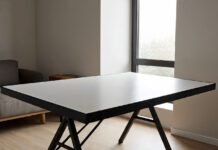Last Updated on March 9, 2025 by Bisma Sehar
When planning a construction project, there are numerous considerations to take into account to ensure the final result meets both functional and aesthetic requirements. Wall coping is an essential element that often goes unnoticed, but it plays a significant role in protecting and enhancing the appearance of a building. In this article, we will explore the concept of wall coping and help you determine if it’s the right choice for your specific project.
Table of Contents
Understanding Wall Coping:
Wall coping refers to the protective covering installed on top of a wall. Its primary purpose is to shield the wall from environmental elements such as rainwater, snow, and sunlight. Coping serves as a vital barrier against water infiltration, preventing moisture from seeping into the underlying masonry. This helps to preserve the structural integrity of the wall, reducing the risk of damage caused by weathering, erosion, and freeze-thaw cycles.
Beyond its functional benefits, wall coping also plays a significant role in the aesthetics of a building. With various materials, colors, and styles available, wall coping can be customized to complement the architectural design, enhancing the overall appearance of the structure.
Determining If Wall Coping Is for You:
1. Climate and Weather Conditions:
The climate in your region is a crucial factor to consider when deciding if wall coping is right for your project. If your area experiences heavy rainfall, snowfall, or high humidity levels, wall coping becomes even more critical. Coping will help prevent water infiltration, protecting the wall from damage caused by moisture over time. Additionally, regions with extreme temperature fluctuations will benefit from coping’s ability to resist freeze-thaw cycles, which can be particularly damaging to masonry.
2. Type of Wall and Location:
The type of wall you are constructing and its location within the building also influences the need for wall coping. External walls exposed to the elements are more vulnerable to water damage and will benefit significantly from coping installation. However, internal walls in areas with high moisture content, such as bathrooms or kitchens, can also benefit from coping to prevent water infiltration and potential damage to adjacent structures.
3. Architectural Design and Aesthetics:
The aesthetic aspect of wall coping should not be overlooked. Consider the overall architectural design of your building and whether the addition of coping complements the style. Wall coping comes in various materials like concrete, natural stone, brick, or metal, each offering different textures and finishes. You can choose coping that seamlessly integrates with the building’s design, enhancing its visual appeal and contributing to a cohesive look.
4. Long-Term Maintenance Considerations:
If you want to reduce long-term maintenance costs and increase the lifespan of your walls, wall coping is a smart choice. The protective layer it provides shields the wall from various weather-related issues, decreasing the need for frequent repairs and replacements. This can save you both time and money in the long run.
5. Safety and Practicality:
Wall coping can add an extra layer of safety and practicality to your building. The rounded edges of coping stones create a smoother surface, reducing the risk of injuries from sharp corners, especially in areas with foot traffic. Additionally, coping prevents rainwater from dripping down the wall’s face, ensuring the immediate vicinity remains dry and safe even during wet weather.
Conclusion:
In conclusion, wall coping offers several benefits that make it a valuable addition to many construction projects. If your building is exposed to harsh weather conditions, requires protection from water infiltration, or if you want to enhance its aesthetics and durability, wall coping is likely the right choice for you. Additionally, if safety and long-term maintenance savings are priorities for your project, investing in coping is a wise decision.
Before proceeding with the installation of wall coping, carefully assess your building’s specific needs and consult with professionals to determine the most suitable materials and designs for your project. With the right wall coping in place, you can ensure the longevity, functionality, and visual appeal of your building for years to come.
For more check out Rainclear Systems.
Apart from that, if you are interested to know about The Right Wall Paint colours then visit our Home Improvement category.
















